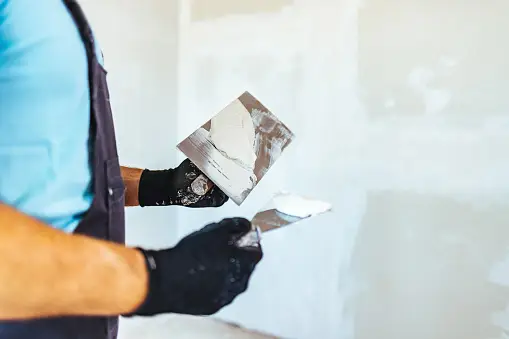To put it simply, Venetian plaster is more than just a coat of paint; it is recognized for its enduring elegance and opulent appeal. The unusual texture and aesthetic depth of this premium wall treatment have contributed to its significant rise in popularity; yet, the beauty of this finish frequently comes at a cost.
It is possible to gain insight into whether or not this amazing wall treatment is within your financial means by gaining an understanding of the components that contribute to the cost of Venetian plaster.

Exploring the intricacies that determine the cost of attaining Venetian plaster walls in your house or project, from the quality of the materials and the competence of the artisans to the customization and surface preparation, is an important step.
Are Venetian Plaster Walls Expensive?
The quality of the materials, the difficulty of the application, and the size of the area to be covered are some of the many variables that can cause the price of Venetian plaster to fluctuate substantially.
As a high-end alternative to more conventional wall coverings like paint or wallpaper, Venetian plaster may be somewhat pricey. Application usually necessitates the use of trained personnel, which might drive up the price.
While the price tag might be on the hefty side, many people think it’s worth it for the distinctive, high-end appearance it generally delivers. Here are a few more factors that can influence the cost of venetian plaster walls:
- Quality of Materials: Higher quality plaster materials, which may contain marble dust or other premium ingredients, can increase the cost.
- Skill of the Applicator: Hiring an experienced artisan or professional to apply Venetian plaster can be more expensive due to their expertise and craftsmanship.
- Surface Preparation: The condition of the walls before applying Venetian plaster can affect costs. Extensive preparation, such as repairing cracks or smoothing surfaces, may be necessary.
- Additional Treatments: Some finishes of Venetian plaster require sealing or waxing after application, which adds to the overall cost.
- Coverage Area: Larger areas or rooms with intricate details can require more time and materials, increasing the cost.
- Customization: Custom colours or special effects can also drive up the price, as they may require more time and expertise to achieve.
Considering these factors, the cost of Venetian plaster walls can vary significantly depending on the specifics of your project and the desired outcome.
Is Venetian Plaster Walls Good To Use?
Venetian plaster walls can be a great choice for various reasons:
- Aesthetic Appeal: They offer a sophisticated, textured finish that adds depth and character to a space, often mimicking the look of natural stone or marble.
- Durability: When applied correctly and sealed properly, Venetian plaster can be quite durable and resistant to wear and tear.
- Versatility: It works well in both traditional and contemporary settings, offering a timeless look that can complement various interior styles.
- Customization: Venetian plaster can be customized in terms of colour, texture, and finish, allowing for unique and personalized designs.
- Natural Materials: It’s typically made from natural materials like lime, marble dust, and other minerals, making it an eco-friendly choice compared to synthetic wall coverings.
However, it’s important to consider factors such as cost, maintenance requirements, and the skills needed for application. Overall, Venetian plaster can enhance the visual appeal and value of a space, making it a favoured option among those seeking a distinctive and elegant wall finish.
Is Venetian Plaster Walls Worth The Money?
Whether Venetian plaster walls are worth the money depends on your preferences, budget, and the specific context of your project. Here are some considerations:
- Aesthetic Value: Venetian plaster provides a luxurious, textured finish that can significantly enhance the appearance of a room. If you value aesthetic appeal and are looking for a distinctive, high-end look, Venetian plaster can be worth the investment.
- Longevity and Durability: When applied correctly and maintained properly, Venetian plaster can be quite durable and long-lasting. Its resistance to wear and tear can contribute to its value over time.
- Versatility: Venetian plaster works well in various interior styles and settings, offering flexibility in design and customization. This versatility can add value in terms of adaptability to different decor schemes.
- Property Value: High-quality finishes like Venetian plaster can potentially increase the resale value of a property, appealing to buyers looking for upscale features.
- Cost Considerations: Venetian plaster can be more expensive than traditional wall finishes like paint or wallpaper due to material costs and skilled labour required for application. It’s essential to weigh this cost against the benefits and the impact it will have on your space.
Whether Venetian plaster walls are worth the money depends on your personal preferences for aesthetics, your budget constraints, and the overall goals you have for your interior design. If you prioritize luxury, durability, and a unique aesthetic, Venetian plaster may be a worthwhile investment.
What Is Special About Venetian Plaster?
Venetian plaster is renowned for several unique characteristics that set it apart from other wall finishes:
- Depth and Texture: Unlike flat paint or wallpaper, Venetian plaster creates a textured surface with depth and dimension. It often mimics the look and feel of natural materials like stone or marble, adding richness and tactile interest to walls.
- Luxurious Appearance: The smooth, polished finish of Venetian plaster gives walls a luxurious and sophisticated appearance. It reflects light differently than flat paints, creating a subtle sheen that enhances the overall ambience of a room.
- Customization: Venetian plaster offers flexibility in terms of colour, texture, and finish. It can be applied in multiple layers and polished to achieve different effects, allowing for custom designs that suit various interior styles and preferences.
- Durability: When applied correctly and sealed properly, Venetian plaster can be highly durable and resistant to scratches and dents. This durability makes it suitable for high-traffic areas and can contribute to its long-term value.
- Natural Ingredients: Typically made from natural materials such as lime, marble dust, and minerals, Venetian plaster is considered more environmentally friendly compared to synthetic wall coverings. It also contributes to a healthier indoor environment by allowing walls to breathe.
- Timelessness: Venetian plaster has been used for centuries, dating back to ancient Roman and Renaissance times. Its timeless appeal and classic beauty have ensured its popularity throughout history and continue to make it a favoured choice in contemporary interior design.
Venetian plaster stands out for its aesthetic versatility, durability, and ability to create a unique and luxurious atmosphere in any space.
Conclusion
When compared to other wall coverings that are more conventional, Venetian plaster stands out owing to the outstanding mix of its aesthetic appeal, longevity, and versatility that it possesses.
Because of its textured and luxurious appearance, which lends an air of sophistication and depth to any space, it is frequently selected by individuals who are interested in making a strong statement with their interior design.
A significant number of homeowners and interior designers believe that Venetian plaster is a worthwhile investment because of its classic appeal and the possibility that it will increase the value of their property.
Nevertheless, to achieve the best possible results and reduce the likelihood of cracking, it is necessary to apply it with competence and to take the necessary precautions. Plaster from Venice can be used to create an environment that is reminiscent of the classical era or to highlight interior design elements that are more current.
